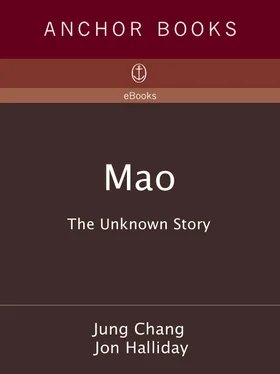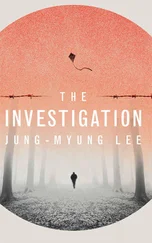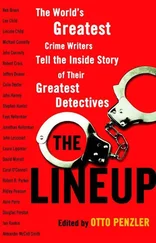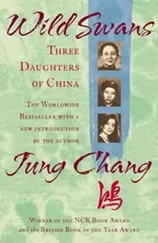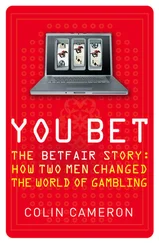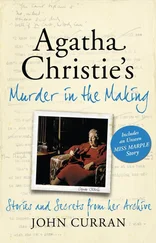68. Lin Biao’s daughter, wife and son “Tiger.” 69. Mao with Che Guevara, 1960.
70. Mao with Imelda Marcos, 1974.
71. Mao with Pol Pot and Ieng Sary, 1975.
72. Mao and Chou En-lai with Nixon and Kissinger, 1972.
73. Chou banished to a hard chair.
74. Deng Xiao-ping and the Gang of Four.
75. Madame Mao at her trial.
76. Mao with Nixon, February 1976.
77. The last picture: Mao with Zulfikar Ali Bhutto, 27 May 1976.
Photograph no. 10, by Auguste François, is reproduced by permission of Réunion des Musées Nationaux; no. 14, by Cecil Beaton, by permission of the Beaton Estate; no.16, by permission of Getty Images; no. 19, by permission of Wang Dan-zhi; nos. 29 and 39, by permission of the Rossiiskii Gosudarstvennyi Arkhiv Kinofotodokumentov (the Russian State Archive of Cine-photo Documents); nos. 34 and 49, by Henri Cartier-Bresson, by permission of Magnum Photos; no. 45, by Du Xiu-xian; no. 53, by Lu Hou-min; nos. 61, 63, 64 and 65, by Li Zhen-sheng; nos. 67, 72, 76 and 77, by Du Xiu-xian.
1. China
2. The area of Mao’s activities, 1927–34
3. The Long March, October 1934–October 1935
Maps by ML Design, London
LIST OF ABBREVIATIONS IN TEXT
CCP Chinese
Communist Party
Cominform
Communist Information Bureau
Comintern
Communist International
CP
Communist Party
8RA
Eighth Route Army
GRU
Glavnoye Razvedyivatelnoye Upravleniye (Chief Intelligence Directorate), Soviet Military Intelligence
N4A
New Fourth Army
ZZZ
Zhang Zhi-zhong
NOTE ABOUT SPELLING IN TEXT
Chinese personal names are given surname first. In some cases, where people have a very common surname, we refer to them by their given names after first mention. We have spelled the names so as to make them as distinctive and easily recognizable as possible. For those not in pinyin (the official Mainland system), the pinyin version is given in the index.
For place names, we have used pinyin , except for Peking (Beijing), Yenan (Yan’an), Canton (Guangzhou), and the islands of Quemoy (Jinmen) and Matsu (Mazu).
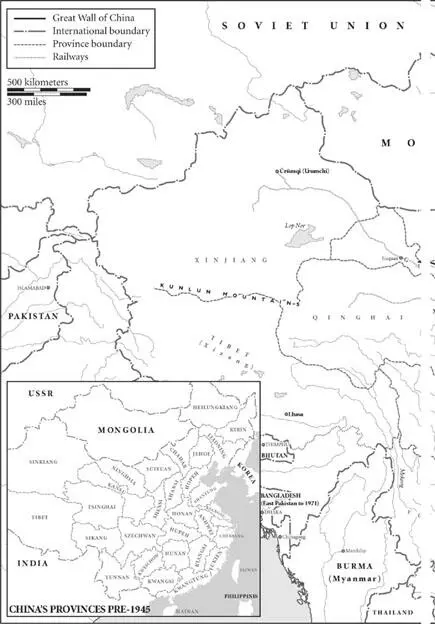
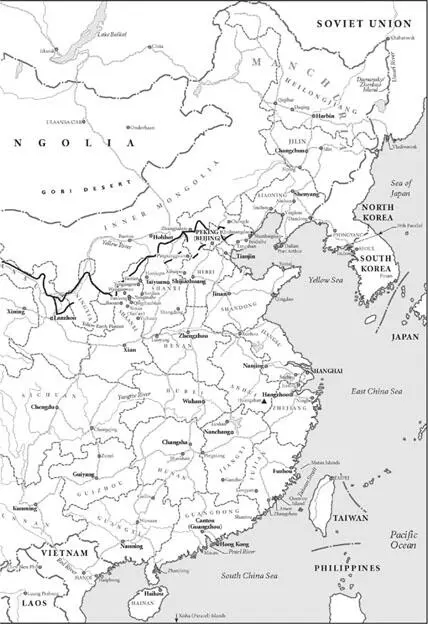
China
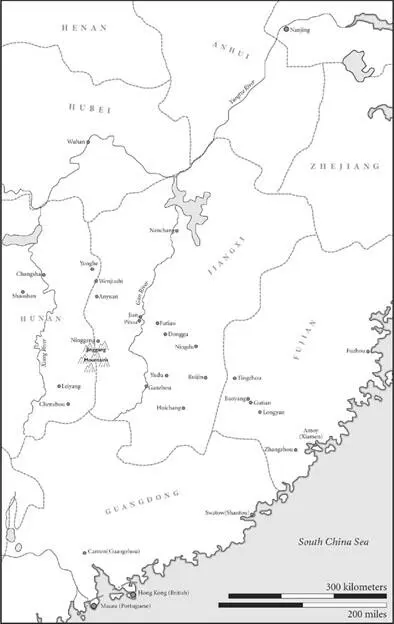
The area of Mao’s activities, 1927–34
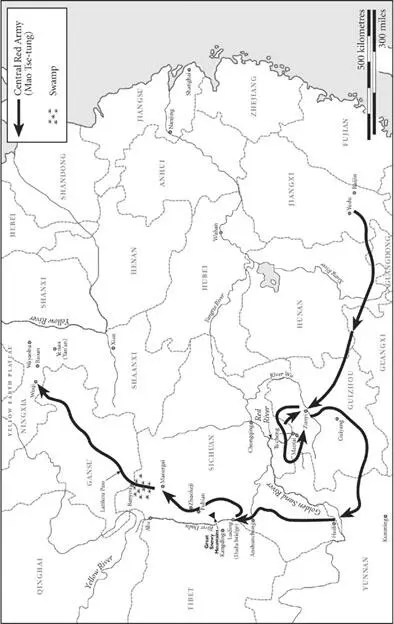
The Long March, October 1934–October 1935
PART ONE
LUKEWARM BELIEVER
1. ON THE CUSP FROM ANCIENT TO MODERN (1893–1911 AGE 1–17)
MAO TSE-TUNG, who for decades held absolute power over the lives of one-quarter of the world’s population, was responsible for well over 70 million deaths in peacetime, more than any other twentieth-century leader. He was born into a peasant family in a valley called Shaoshan, in the province of Hunan, in the heartland of China. The date was 26 December 1893. His ancestors had lived in the valley for five hundred years.
This was a world of ancient beauty, a temperate, humid region whose misty, undulating hills had been populated ever since the Neolithic age. Buddhist temples dating from the Tang dynasty (AD 618–906), when Buddhism first came here, were still in use. Forests where nearly 300 species of trees grew, including maples, camphor, metasequoia and the rare ginkgo, covered the area and sheltered the tigers, leopards and boar that still roamed the hills. (The last tiger was killed in 1957.) These hills, with neither roads nor navigable rivers, detached the village from the world at large. Even as late as the early twentieth century an event as momentous as the death of the emperor in 1908 did not percolate this far, and Mao found out only two years afterwards when he left Shaoshan.
The valley of Shaoshan measures about 5 by 3.5 km. The 600-odd families who lived there grew rice, tea and bamboo, harnessing buffalo to plough the rice paddies. Daily life revolved round these age-old activities. Mao’s father, Yi-chang, was born in 1870. At the age of ten he was engaged to a girl of thirteen from a village about ten kilometers away, beyond a pass called Tiger Resting Pass, where tigers used to sun themselves. This short distance was long enough in those years for the two villages to speak dialects that were almost mutually unintelligible. Being merely a girl, Mao’s mother did not receive a name; as the seventh girl born in the Wen clan, she was just Seventh Sister Wen. In accordance with centuries of custom, her feet had been crushed and bound to produce the so-called “three-inch golden lilies” that epitomized beauty at the time.
Her engagement to Mao’s father followed time-honored customs. It was arranged by their parents and was based on a practical consideration: the tomb of one of her grandfathers was in Shaoshan, and it had to be tended regularly with elaborate rituals, so having a relative there would prove useful. Seventh Sister Wen moved in with the Maos upon betrothal, and was married at the age of eighteen, in 1885, when Yi-chang was fifteen.
Shortly after the wedding, Yi-chang went off to be a soldier to earn money to pay off family debts, which he was able to do after several years. Chinese peasants were not serfs but free farmers, and joining the army for purely financial reasons was an established practice. Luckily he was not involved in any wars; instead he caught a glimpse of the world and picked up some business ideas. Unlike most of the villagers, Yi-chang could read and write, well enough to keep accounts. After his return, he raised pigs, and processed grain into top-quality rice to sell at a nearby market town. He bought back the land his father had pawned, then bought more land, and became one of the richest men in the village.
Though relatively well off, Yi-chang remained extremely hardworking and thrifty all his life. The family house consisted of half a dozen rooms, which occupied one wing of a large thatched property. Eventually Yi-chang replaced the thatch with tiles, a major improvement, but left the mud floor and mud walls. The windows had no glass — still a rare luxury — and were just square openings with wooden bars, blocked off at night by wooden boards (the temperature hardly ever fell below freezing). The furniture was simple: wooden beds, bare wooden tables and benches. It was in one of these rather spartan rooms, under a pale blue homespun cotton quilt, inside a blue mosquito net, that Mao was born.
MAO WAS THE third son, but the first to survive beyond infancy. His Buddhist mother became even more devout to encourage Buddha to protect him. Mao was given the two-part name Tse-tung. Tse , which means “to shine on,” was the name given to all his generation, as preordained when the clan chronicle was first written in the eighteenth century; tung means “the East.” So his full given name meant “to shine on the East.” When two more boys were born, in 1896 and 1905, they were given the names Tse-min ( min means “the people”) and Tse-tan ( tan possibly referred to the local region, Xiang tan ).
These names reflected the inveterate aspiration of Chinese peasants for their sons to do well — and the expectation that they could. High positions were open to all through education, which for centuries meant studying Confucian classics. Excellence would enable young men of any background to pass imperial examinations and become mandarins — all the way up to becoming prime minister. Officialdom was the definition of achievement, and the names given to Mao and his brothers expressed the hopes placed on them.
Читать дальше
